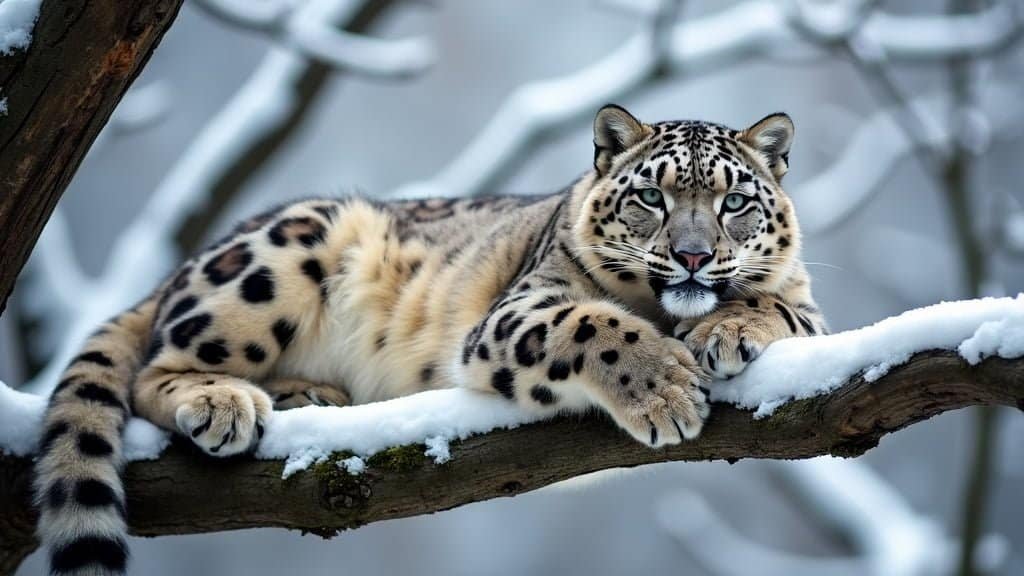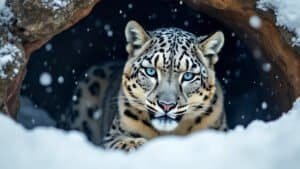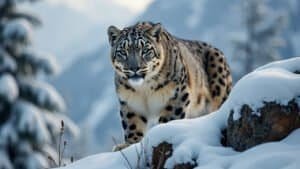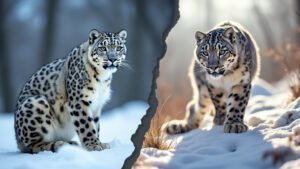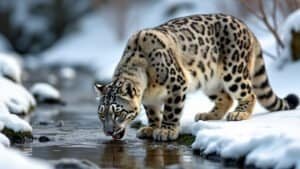Introduction
Snow leopards are majestic and elusive big cats primarily found in the high mountain ranges of Central and South Asia. This article explores their natural habitat, geographic distribution, and the significant conservation efforts aimed at protecting these endangered animals
We will delve into their presence in the wild within Asia, examine any potential existence outside of this region, and discuss the role of zoos and sanctuaries in their preservation. Additionally, we will address the global efforts to maintain and grow the snow leopard population, ensuring their survival for future generations
Natural Habitat of Snow Leopards
Snow leopards thrive in some of the harshest environments on Earth, primarily found in the rugged terrains of Central and South Asia
Their natural habitat is characterized by high-altitude mountains, steep cliffs, and cold, arid landscapes. These elusive big cats have developed remarkable adaptations to survive in such extreme conditions, playing a crucial role in the balance of their ecosystem
Natural Terrain and Climate
Snow leopards are adapted to live in high-altitude regions, typically ranging from 9,800 to 14,800 feet above sea level. These areas include the Himalayas, the Karakoram range, and the Tibetan Plateau
The terrain is rocky, with sparse vegetation, making it an ideal hunting ground for these predators. The climate in these regions is harsh, with temperatures often dropping below freezing and heavy snowfall during the winter months. Snow leopards have thick fur, long tails, and large paws that help them navigate and stay warm in these cold environments
Adaptations to Environment
The snow leopard’s physical characteristics are specifically suited to its cold and mountainous habitat. Their thick fur provides insulation against the cold, while the fur-covered feet act as natural snowshoes, distributing their weight to prevent sinking into the snow
Their powerful hind legs enable them to leap great distances, sometimes as far as 50 feet, which is essential for navigating the rugged terrain and hunting agile prey such as blue sheep, ibex, and marmots
Snow leopards also have a keen sense of sight and hearing, allowing them to detect prey from great distances. Their long, muscular tails aid in balance on the steep, rocky slopes and serve as blankets to protect their face and nose from the cold while resting
Role in the Ecosystem
Snow leopards are apex predators and play a vital role in maintaining the health of their ecosystem. By preying on herbivores such as blue sheep and ibex, they help regulate the populations of these animals, which in turn affects the vegetation and overall health of the environment
This top-down regulation ensures that the ecosystem remains balanced and prevents overgrazing, which could lead to soil erosion and loss of plant life
In addition to their ecological role, snow leopards are also indicators of the health of their environment. A stable or increasing population of snow leopards typically signifies a healthy ecosystem, whereas a declining population can indicate environmental issues such as habitat loss, poaching, or climate change
Conservation efforts for snow leopards often involve protecting large areas of their habitat, which benefits many other species that share the same environment
Geographic Distribution in Asia
Snow leopards are primarily found in the mountainous regions of Central and South Asia. These areas provide the perfect conditions for their survival, with their challenging terrain and harsh climates
In this section, we will explore the specific countries and key mountain ranges that serve as the natural habitats for snow leopards, as well as the population densities within these regions
Countries with Native Populations
Snow leopards inhabit a range of countries across Asia, including Afghanistan, Bhutan, China, India, Kazakhstan, Kyrgyzstan, Mongolia, Nepal, Pakistan, Russia, Tajikistan, and Uzbekistan
China holds the largest population of snow leopards, accounting for an estimated 60% of their global range. India, particularly the regions of Jammu and Kashmir, Himachal Pradesh, Uttarakhand, Sikkim, and Arunachal Pradesh, also hosts significant populations of these big cats
In Nepal, snow leopards are found primarily in the Himalayan region, which includes the Annapurna and Everest areas
Key Mountain Ranges
The snow leopard’s distribution is closely tied to several major mountain ranges in Asia. The Himalayas, which span across five countries (India, Nepal, Bhutan, China, and Pakistan), are one of the primary habitats
These mountains provide the necessary elevation and rugged terrain that snow leopards prefer. The Tibetan Plateau, a vast elevated plateau in Central Asia, also supports a significant number of snow leopards
The Pamir Mountains, located at the junction of Central Asia, are another crucial habitat. This range spans several countries, including Tajikistan, Kyrgyzstan, and Afghanistan. Additionally, the Altai Mountains in Mongolia and Russia, and the Tien Shan Mountains in Kazakhstan, Kyrgyzstan, and China, are key areas where snow leopards are found
Population Density
Estimating the population density of snow leopards is challenging due to their elusive nature and the remote, rugged areas they inhabit. However, it is estimated that there are between 4,000 and 6,500 snow leopards left in the wild
The population density varies greatly depending on the region and the availability of prey. For example, in parts of Mongolia and Kyrgyzstan, snow leopard populations are relatively higher due to abundant prey species and suitable habitat
Conversely, in regions where human encroachment and habitat degradation are prevalent, such as parts of China and India, snow leopard populations are more fragmented and lower in density. Conservation efforts are focused on protecting these key habitats and ensuring the survival of both the snow leopards and their prey species
Conservation Efforts
Snow leopards are listed as vulnerable by the International Union for Conservation of Nature (IUCN), with their populations declining due to habitat loss, poaching, and climate change
To combat these threats, various international and national organizations are actively involved in conservation efforts aimed at protecting and preserving snow leopard populations. In this section, we will explore international conservation programs, success stories and challenges, and conservation initiatives outside of Asia
International Conservation Programs
Several international organizations are dedicated to snow leopard conservation. The Snow Leopard Trust, established in 1981, is one of the leading organizations in this field. It focuses on community-based conservation programs in snow leopard habitats across Central Asia
These programs include livestock insurance schemes to reduce human-wildlife conflict, eco-friendly income generation activities for local communities, and educational initiatives to raise awareness about snow leopards
Another significant initiative is the Global Snow Leopard & Ecosystem Protection Program (GSLEP), launched in 2013. This multi-national effort involves 12 snow leopard range countries working together to secure 20 snow leopard landscapes by 2020
The program emphasizes habitat protection, community involvement, and international cooperation to address the threats facing snow leopards
Success Stories and Challenges
There have been several success stories in snow leopard conservation. In Mongolia, the Snow Leopard Trust’s community-based programs have led to a reduction in poaching and an increase in snow leopard populations in certain areas
Similarly, in India, the establishment of the Hemis National Park in Ladakh has provided a safe haven for snow leopards, with the park now home to one of the highest densities of these big cats in the country
However, challenges remain. Human-wildlife conflict is a significant issue, as snow leopards sometimes prey on livestock, leading to retaliation by herders
Efforts to mitigate this conflict, such as the Snow Leopard Trust’s livestock insurance program, have shown promise but require continued support and expansion. Poaching for their fur and bones, driven by illegal wildlife trade, also poses a persistent threat. Strengthening anti-poaching measures and enforcing wildlife protection laws are critical to addressing this issue
Conservation Outside of Asia
While snow leopards are native to Asia, conservation efforts have also extended beyond this region. Zoos and wildlife sanctuaries around the world play a vital role in snow leopard conservation through captive breeding programs, public education, and fundraising for in-situ conservation projects
The Snow Leopard Species Survival Plan, coordinated by the Association of Zoos & Aquariums (AZA) in North America, focuses on maintaining a healthy and genetically diverse captive population of snow leopards
Educational initiatives in zoos help raise awareness about snow leopards and the challenges they face in the wild. By educating visitors about the importance of snow leopard conservation, these institutions contribute to a broader understanding and support for global conservation efforts
In Europe, the European Endangered Species Programme (EEP) for snow leopards coordinates the breeding of snow leopards in European zoos, ensuring genetic diversity and collaborating with conservation projects in the wild. This program has successfully bred and raised snow leopards, contributing to the overall conservation of the species
Snow Leopards in Captivity
Captive snow leopards play a crucial role in conservation efforts, serving as ambassadors for their species and contributing to breeding programs aimed at maintaining genetic diversity
Zoos and wildlife sanctuaries around the world are involved in these initiatives, providing care, conducting research, and educating the public about snow leopard conservation
Zoos and Wildlife Sanctuaries
Zoos and wildlife sanctuaries across the globe house snow leopards, offering a safe environment where these animals can live and breed under human care. Some prominent zoos with successful snow leopard programs include the Bronx Zoo in New York, the San Diego Zoo, and the Woodland Park Zoo in Seattle
These institutions not only provide excellent care for snow leopards but also engage in public education and fundraising for conservation efforts in the wild
Wildlife sanctuaries, such as the Big Cat Rescue in Florida and the Shambala Preserve in California, also play a vital role in caring for snow leopards that cannot be released back into the wild. These sanctuaries offer a naturalistic environment where snow leopards can thrive, often rescuing animals from circuses, illegal trade, or unsuitable private ownership
Breeding Programs
Captive breeding programs are essential for ensuring the long-term survival of snow leopards. These programs are carefully managed to maintain genetic diversity and avoid inbreeding
The Snow Leopard Species Survival Plan (SSP) in North America and the European Endangered Species Programme (EEP) are two key initiatives that coordinate the breeding of snow leopards in captivity
Breeding programs have been successful in increasing the population of snow leopards in captivity. For instance, the Bronx Zoo’s snow leopard breeding program has produced numerous cubs over the years, contributing to the genetic pool of the captive population. These programs also collaborate with in-situ conservation projects, supporting efforts to protect snow leopards in the wild
Educational and Research Initiatives
Zoos and sanctuaries are instrumental in educating the public about snow leopards and the threats they face
Through interactive exhibits, educational programs, and special events, these institutions raise awareness and foster a connection between visitors and wildlife. The goal is to inspire action and support for snow leopard conservation efforts worldwide
Research conducted in captivity also contributes to our understanding of snow leopard biology, behavior, and health. Studies on reproduction, genetics, and disease can provide valuable insights that inform conservation strategies in the wild. For example, research on the dietary needs and health care of snow leopards in captivity helps improve their management and well-being
Conclusion
Snow leopards are magnificent and elusive big cats primarily found in the mountainous regions of Central and South Asia
Their natural habitat is characterized by rugged terrains, high altitudes, and harsh climates, making them well-adapted to these extreme environments. These apex predators play a vital role in maintaining the health of their ecosystem by regulating the populations of herbivores and preventing overgrazing
Geographically, snow leopards are distributed across several countries in Asia, with China holding the largest population. The key mountain ranges that serve as their natural habitats include the Himalayas, the Tibetan Plateau, the Pamir Mountains, the Altai Mountains, and the Tien Shan Mountains. Despite their wide distribution, estimating the exact population density of snow leopards is challenging due to their elusive nature and the remote areas they inhabit
Conservation efforts for snow leopards are multifaceted and involve international cooperation, community engagement, and educational initiatives
Organizations such as the Snow Leopard Trust and the Global Snow Leopard & Ecosystem Protection Program (GSLEP) are actively working to protect and preserve snow leopard populations. While significant progress has been made, challenges such as human-wildlife conflict and poaching persist, requiring sustained efforts and innovation
Captive snow leopards play a crucial role in these conservation efforts. Zoos and wildlife sanctuaries around the world provide care, conduct research, and educate the public about snow leopard conservation. Breeding programs, such as the Snow Leopard Species Survival Plan (SSP) and the European Endangered Species Programme (EEP), are essential for maintaining genetic diversity and supporting in-situ conservation projects
